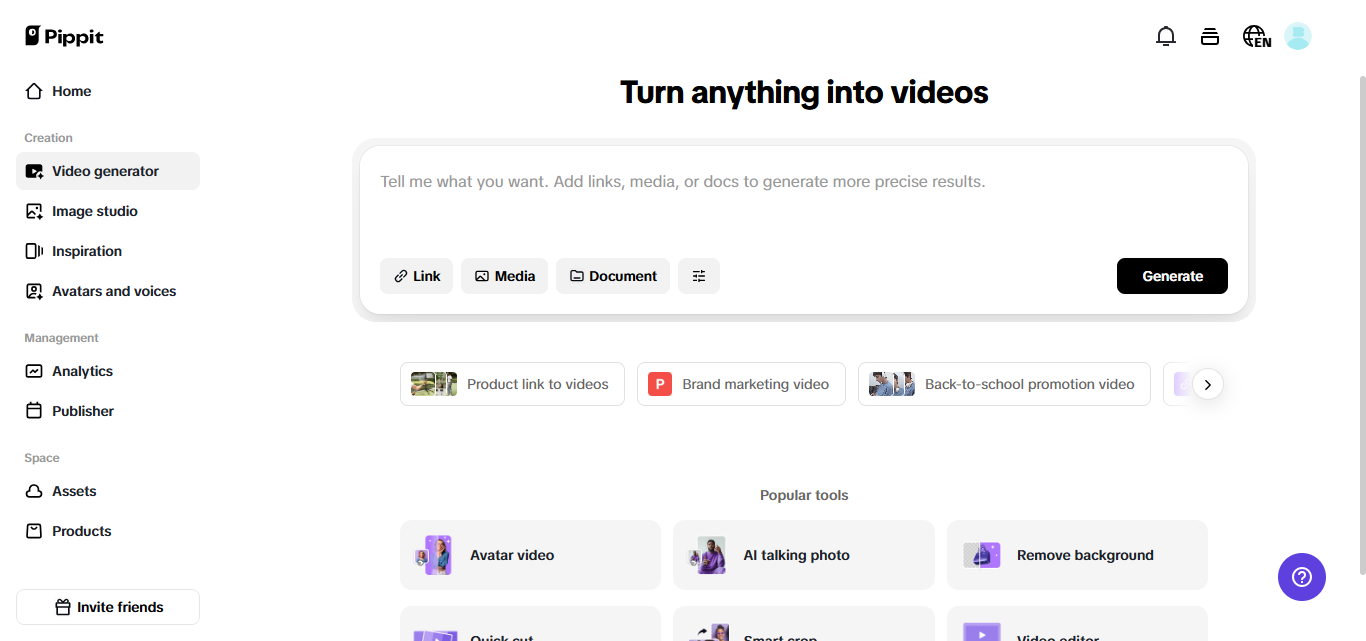Ever curious about how some videos go viral—literally, without making a sound? No trending audio. No voiceover. No music. Just clean visuals, concise text, and thoughtful pacing. If your content strategy is still very centered around sound, perhaps it’s time to silence the mic.
With tools such as Pippit’s text to video AI to convert product pages, blog posts, or URLs into complete short-form videos. The catch? These videos tend to perform better in silence. Channels such as Instagram Reels and YouTube Shorts favor content that is snappy, concise, and made for scroll-through viewers in silence. And silent videos are taking the cake.
Let’s dive into why no-sound posts are appearing increasingly in Explore tabs and Shorts feeds—and how to make them without recording a single second of video or audio yourself.
The rise of silent engagement
When did you last take a look at a Reel in public with volume turned on? Never, most likely. In fact, more than 80% of mobile video is watched with the sound off, per several marketing studies. It’s not a user behavior glitch, it’s a trend that platforms have adjusted to.
So what does this imply for marketers and creators? Videos that do well in silence tend to have higher completion rates, greater shares, and improved watch time. And because algorithms are designed to drive up content that engages users, silent videos are rising higher and higher in the charts.
Takeaway: audio isn’t always doing your content a favor—often it’s hindering it.
Example of Pippit’s quiet power: from link to loop
Suppose you’ve got a product page or article describing your offering nicely. Rather than a voiceover recording or looking for royalty-free music, you can just insert that URL into Pippit’s text to video creator. In seconds, you’ve got a short-form video with animations, transitions, and brand-matched text overlays. No shooting. No editing calendars. No mic checks.
And since these videos are constructed on clean visuals, the optimal finishing technique is to remove audio from video altogether—transforming your content into a universal, distraction-free scroll magnet using Pippit. Here’s how:
Want to keep viewers watching? remove audio from video
After creating your video, it’s time to remove the unnecessary layers. Here’s how Pippit assists you in fine-tuning it to perfection:
Step 1: upload your video file
After creating your content with Pippit, go to the Remove Audio tool. Drag and upload your video file or paste in the video URL. The software will support formats such as .mp4 and .mov and start searching for embedded audio immediately when your upload is complete.
Step 2: strip the audio track
Press the “Mute” button, or exclude specific audio tracks. If it’s a poor quality voiceover or ambiance from a stock clip, the plugin allows you to preview the silent track in real-time. It’s quiet, clean, and immediately more flexible.
Step 3: export or add new sound
Once you’re happy, save the mute version—or go into Pippit’s full video editor and add more suitable sounds. Consider gentle whooshes, soft background music, or even a branded jingle. Or leave it quiet for a minimalist look. Either way, you’re in charge.
Why silence converts: platform-by-platform breakdown
Instagram Reels – Instagram’s default auto-play mode is muted video, particularly when people are scrolling in the middle. Visually attention-grabbing videos, using bright text, clear transitions, or visual contrast, will receive greater dwell time.
YouTube Shorts – Though Shorts permit audio, their interface remains visual-first. Short, quiet explainers or product demos that don’t need context through audio will be replayed more.
Facebook & LinkedIn – Both of these sites are heavily browsed during working hours or in settings where the sound is muted.
The psychology behind silent success
Removing the sound minimizes friction. Rather than viewers requiring earbuds or volume adjustment, they can simply watch. This small gain tends to result in improved user experience, and that directly translates into engagement.
Silent videos are also more accessible. Hearing-impaired viewers, non-native speakers, or just those in quiet places can all see the same message. And, silence gets a very specific type of attention. Amidst a stream of boisterous, attention-grabbing noise, a silent, visuals-only video can be noticeable simply because it’s not yelling.
Best use cases for silent short-form content
E-Commerce Product Features – Don’t explain the feature—demonstrate it. Then throw a bold overlay such as “Waterproof up to 50m” or “72 hour battery life.” These words don’t require narration.
Explainer Snippets – Transform a how-to blog post or tutorial into a 30-second mute animation. It’s consumable, replicable, and ideal for mobile.
Brand Story Highlights – If you wish to display your mission, values, or back-end processes, do so visually. Employ compelling imagery and words without imposing on users with music or narration.
Don’t confuse silence with boring
Other creators worry that taking away audio will render their videos boring. Actually, it renders them cleaner. But only when the visual narrative is solid.
These are a couple of improvements that can help your silent videos stand out:
- Overlay kinetic typography to highlight key phrases
- Employ close-ups and seamless transitions
- Include your brand colors using text or overlays
- Time animations to a beat, even in silence
These tricks have the viewer engaged from beginning to end—without having to listen to a word.
Make silence your strategy
In a world where everyone is yelling to be heard, at times the softest voices sound the loudest. By embracing silent video strategy, with the assistance of technology such as Pippit’s text to video tool, you not only preserve time and budget, but increase performance across all platforms.
Start with Pippit today, and let your visuals do the talking.

